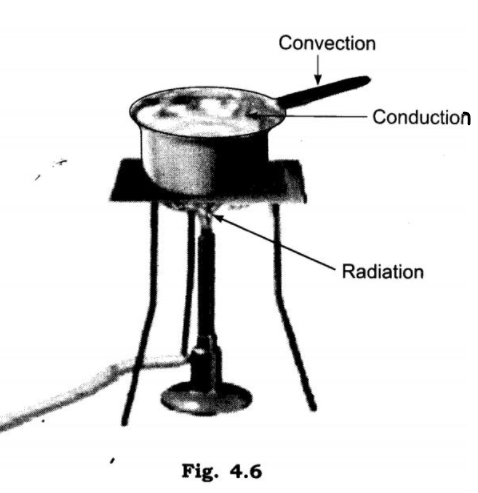NCERT Solutions for Class 7 Science Chapter 4 Heat
NCERT Solutions for Class 7 Science Chapter 4 Heat
Exercises
Question:- 1. State similarities and differences between the laboratory thermometer and the clinical thermometer.
Answer:- Similarities
- Both are made of glass and having a long narrow glass tube.
- Both of them have a bulb at one end.
- Both thermometers’ bulbs are made of mercury.
- Both the thermometer have a Celsius scale.
Differences:-
Clinical Thermometer | Laboratory thermometer |
Temperature range if 35 to 42 0 c | Temperature range is -10 to 110 0 c |
Used to measure human body temperature | Used to measure temperature in the laboratory |
It has kink which prevents immediate backflow of mercury | It does not have a kink |
Question:- 2. Give two examples each of conductors and insulators of heat.
Answer:- Example of conductors:– Iron and Copper
Example of insulators:- Plastic and wood
Question:- 3. Fill in the blanks :
(a) The hotness of an object is determined by its __________.
(b) Temperature of boiling water cannot be measured by a _____________ thermometer.
(c) Temperature is measured in degree ______________.
(d) No medium is required for transfer of heat by the process of __________.
(e) A cold steel spoon is dipped in a cup of hot milk. Heat is transferred to its other end by the process of ______________.
(f ) Clothes of ______________ colours absorb more heat better than clothes of light colours.
Answer:- (a) The hotness of an object is determined by its temperature,
(b) Temperature of boiling water cannot be measured by a clinical thermometer.
(c) Temperature is measured in degree Celsius.
(d) No medium is required for transfer of heat by the process of radiation.
(e) A cold steel spoon is dipped in a cup of hot milk. Heat is transferred to its other end by the process of conduction.
(f ) Clothes of dark colours absorb more heat better than clothes of light colours.
Question:- 4. Match the following :
(i) Land breeze blows during | (a) summer |
(ii) Sea breeze blows during | (b) winter |
(iii) Dark coloured clothes are preferred during | (c) day |
(iv) Light coloured clothes are preferred during | (d) night |
Answer:-
(i) Land breeze blows during | (d) night |
(ii) Sea breeze blows during | (c) day |
(iii) Dark coloured clothes are preferred during | (b) winter |
(iv) Light coloured clothes are preferred during | (a) summer |
Question:- 5. Discuss why wearing more layers of clothing during winter keeps us warmer than wearing just one thick piece of clothing .
Answer:- In the winter, more layers of clothing keep us warm since there is more space between them. This area is gradually filled with air. Air is a poor conductor of heat and does not enable it to escape.
Question:- 6. Look at Fig. 4.13. Mark where the heat is being transferred by conduction, by convection and by radiation.
Answer:-

Question:- 7. In places of hot climate it is advised that the outer walls of houses be painted white. Explain.
Answer:- In hot climates, it is recommended that the outer walls of houses be painted white since white reflects heat and keeps the house cool.
Question:- 8. One litre of water at 30°C is mixed with one litre of water at 50°C. The temperature of the mixture will be
(a) 80°C (b) more than 50°C but less than 80°C
(c) 20°C (d) between 30°C and 50°C
Answer:- (d) between 30°C and 50°C
Question:- 9. An iron ball at 40°C is dropped in a mug containing water at 40°C. The heat will
(a) flow from iron ball to water.
(b) not flow from iron ball to water or from water to iron ball.
(c) flow from water to iron ball.
(d) increase the temperature of both.
Answer:- (b) not flow from iron ball to water or from water to iron ball.
Question:- 10. A wooden spoon is dipped in a cup of ice cream. Its other end
(a) becomes cold by the process of conduction.
(b) becomes cold by the process of convection.
(c) becomes cold by the process of radiation.
(d) does not become cold.
Answer:- (d) does not become cold.
Question:- 11. Stainless steel pans are usually provided with copper bottoms. The reason for this could be that
(a) copper bottom makes the pan more durable.
(b) such pans appear colourful.
(c) copper is a better conductor of heat than the stainless steel.
(d) copper is easier to clean than the stainless steel.
Answer:- (c) copper is a better conductor of heat than the stainless steel.